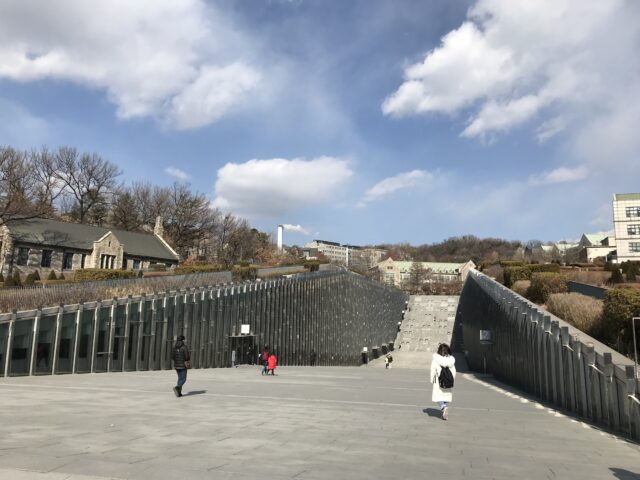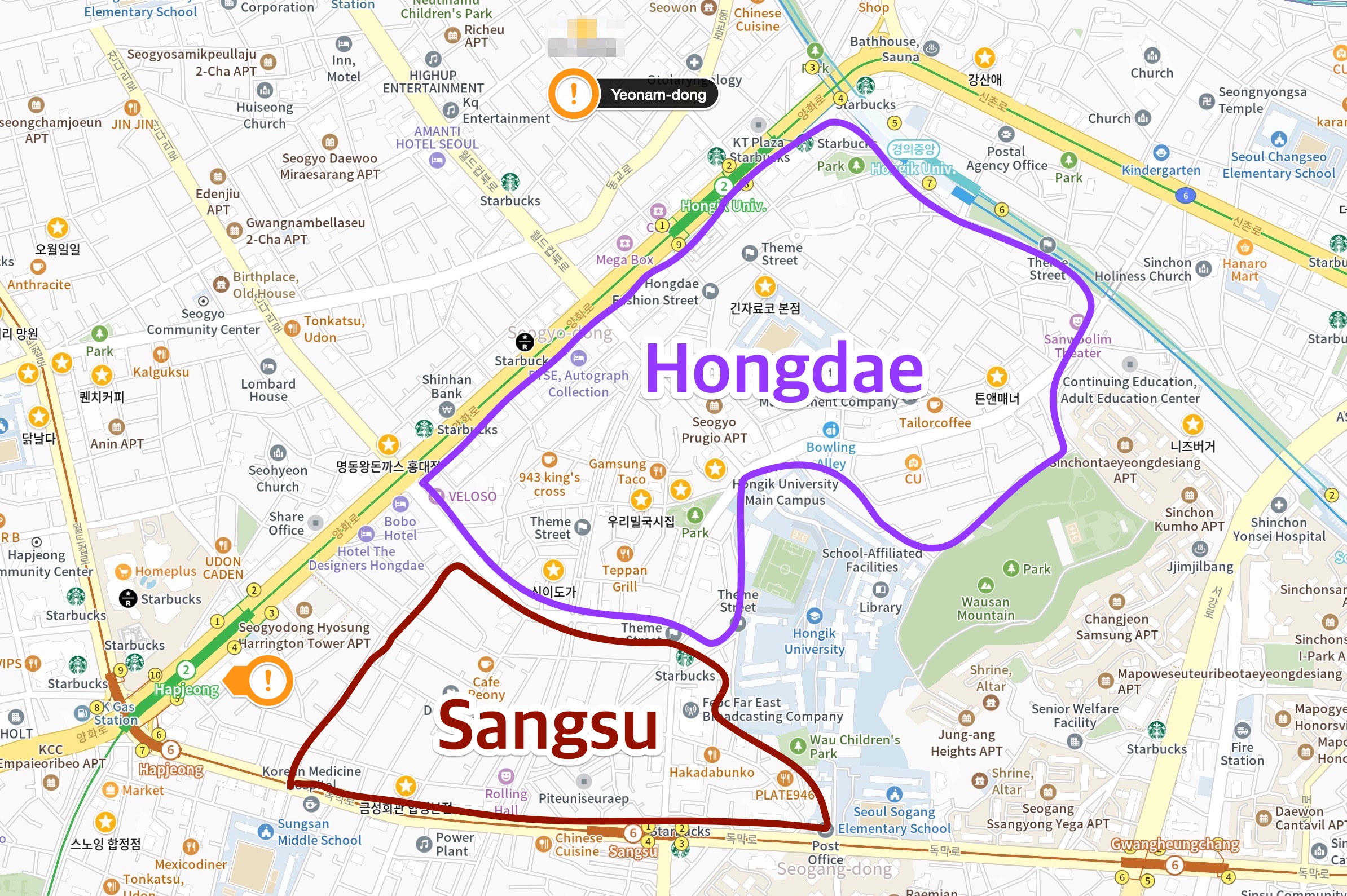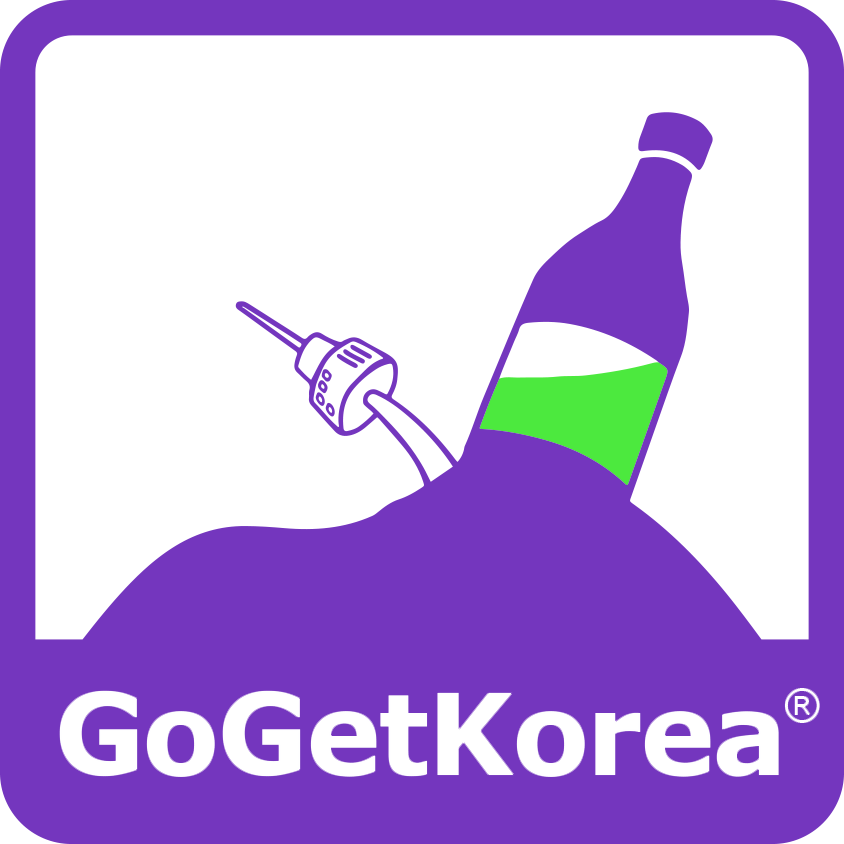The tourist attractions included in this itinerary





Explore Seoul’s vibrant youth culture, and urban oasis at these exciting destinations.
The Route
Shinchon, Ehwa Woman’s University areas are walkable. Seonyudo Park and Hongdae can be accessed by subway or bus. You can check the subway exits on this itinerary for each attraction in case you want to visit separately.


1. Shinchon 신촌
Lively area known for its numerous universities. Immerse yourself in the lively energy of Shinchon, a trendy district filled with hip cafes, fashionable boutiques, and vibrant street art including Yeonsei, Ehwa and Seogang University.
Fun Fact: This is a must-visit destination for those seeking budget-friendly options for food and drinks.


- Subway: Take Exit 2 or 3 at Sinchon Subway Station (not the railway station), on line no.2 (green line).
- Things to do: Arrive with an appetite as this area offers a wide selection of affordable and delicious restaurants and cafes. Explore the charming alleys to discover hidden gems such as chicken places, Samgyepsal eateries, beer bars, and more. Don’t miss the lively street performances by talented artists in the evening.
- Estimated Time for this activity: 1 hour and 30 minutes.
2. Edae (Ehwa Woman’s Unversity) 이대 (이화 여자 대학교)
Discover the youthful charm of Edae, home to Ehwa Woman’s University. Shop at trendy fashion boutiques, enjoy cozy cafes, and experience the vibrant student culture.
Insider Info: While it has diminished in popularity over time, there are still plenty of affordable restaurants, bubble tea shops, and cafes to explore in this area.


- Subway: Take Exit 2 or 3 at Ewha Woman’s University Station, on line no.2 (green line).
- Address: 52, Ewhayeodae-gil, Seodaemun-gu, Seoul / 서울특별시 서대문구 이화여대길 52(대현동)
- Things to do: Discover a variety of individual clothing stores, accessory shops, hair salons, cosmetics shops, bubble tea places, and cafes that cater to diverse tastes.
- Estimated Time for this activity: 1 hour.
3. Seonyudo Park 선유도 공원
Escape the city’s hustle and bustle at Seonyudo Park, a serene urban oasis with beautiful gardens, scenic walking paths, and a tranquil island that offers breathtaking views.
Additional Info: Seonyudo Park is an island located in the Han River, Seoul, Korea. Originally a small mountain known as Seonyubong, it was separated from the mainland during the Japanese colonial era. From 1978 to 2000, it served as a water filtration plant, supplying tap water to the southwestern part of Seoul. In December 2000, it underwent a transformation and was opened to the public as a park. On April 26, 2002, Seonyudo Park was officially accessible to the public.


- Subway: Exit 2 of Seonyudo Station, line no.9 (mustard line)
- Address: 343, Seonyu-ro, Yeongdeungpo-gu, Seoul / 서울특별시 영등포구 선유로 343
- Opening Hours: 6:00 AM -12:00 AM
- Estimated Time for this activity: 2 hours.
Directions: If you’re coming from the Shinchon or Hongdae area, take the green line (line no.2) and transfer at Dangsan Station to the mustard line (line no.9) heading west. Get off at the next stop and take Exit 2 of Seonyudo Station.
🚌 If you prefer to travel by bus, the most convenient option is bus number 5714, and you should alight at Seonyudo stop. There is also bus number 602 that goes to Yanghwadaegyo (Yanghwa Bridge) Jeonmang Café Stop. If you choose this bus, you’ll need to walk back for about 5 minutes, which is the second-best option. Avoid taking other buses as they may cause unnecessary confusion. Once you finish exploring this park, you can cross Seonyu Bridge within the park to reach Hangang Park.


4. Sangsu 상수
Indulge in the artistic and creative atmosphere of Sangsu, known for its unique galleries, independent boutiques, and eclectic cafes. Experience the dynamic fusion of art, fashion, and culture.
Insider Info: In the area, you’ll find long-standing and unique shops that always have a line of customers waiting. There is a strong presence of small-scale artisanal bakeries and Japanese fusion restaurants. In the vicinity of Yeouido and Mapo, there is a café street district that locals use for dates and meetups, avoiding the bustling business area of Hongdae. This area is connected to Hongdae’s commercial district and has grown independently, establishing itself as a stable and thriving Sangsu commercial area.


- Subway: Take Exit 1 or 2 of Sangsu Station, on line no.6 (brown line).
- Things to do: Explore the renowned coffee street in this area. Discover a variety of unique restaurants, dessert cafes, and coffee shops that will satisfy your cravings. Don’t miss the opportunity to browse through the street stalls offering handmade accessories and goods. If you’re a regular visitor to Hongdae, make sure to extend your exploration to Sangsu for a wider range of experiences.
- Estimated Time for this activity: 1 hour and 30 minutes.
5. Hongdae 홍대
Immerse yourself in the vibrant energy of Hongdae, the heart of Seoul’s youth culture. Explore its lively streets filled with street performances, live music venues, trendy shops, and vibrant nightlife.
Insider Tip: The Hongdae station, officially called “홍대입구역” (Hongdae ipgu-yeok), gets its name from its location near the entrance of Hongik University (홍익 대학교), colloquially known as 홍대 (Hongdae). “입구” (ipgu) in Korean means “entrance,” reflecting its position at the foot of the university campus. This station serves as a portal to the vibrant Hongdae district, famed for its youthful ambiance, creativity, trendy stores, lively street performances, and bustling nightlife.


- Subway: Take Exit 8 or 9 of Hongik University Station, on line no.2 (green line).
- Things to do: Enjoy the vibrant street buskers and indie art culture that define this area. Explore the abundance of unique cafes, young designer clothing shops, accessory stores, clubs, theaters, and captivating graffiti adorning the walls. Hongdae transforms into a bustling festival town, offering an array of dancing, music, and lively clubbing scenes. Enjoy shopping, indulging in delicious snacks, immersing yourself in entertainment, and experiencing the local culture. As night falls, be treated to captivating performances by talented indie buskers, showcasing their singing, dancing, and other remarkable talents.
- Cafés: Discover an array of unique cafes, including cat cafes, cartoon cafes, sheep cafes, meerkat cafes, wedding cafes, and more.
- Hongdae Flea Market: Don’t miss the Hongdae Free Market held at Hongik Children’s Park every Saturday from 13:00 to 18:00, running from March to November.
- Estimated Time for this activity: 3 hours.
- ‼️Warning: Hongdae F-boys want to ‘experience‘ you.
The Map of Picasso Street
Picasso Street: It is a street of wall paintings from the College of Fine Arts at Hongik University. This is also a well-known location for K-dramas. See the above route.
Tips: You can start your tour from exit 8 and 9 of Hongdae Station or exit 3 or 4 of Sangsu Station. Continue your tour in Yeonam-dong area full of international cuisines, Chinese restaurants, cafes and design shops.
FAQ about Hongdae
What is Hongdae known for?
Why is Hongdae popular?
1. Youthful and Creative Energy: Hongdae is a vibrant and dynamic neighborhood that attracts young people and students. It exudes a youthful energy and creativity that is reflected in its arts, fashion, music, and cultural scene.
2. Indie Music and Performance Culture: Hongdae is known as a hub for indie music and live performances. It is home to numerous live music clubs, small concert venues, and street performers, offering a platform for emerging artists and musicians to showcase their talent.
3. Trendy Fashion and Shopping: The area is renowned for its trendy fashion boutiques, unique clothing stores, and independent designers. Fashion-forward individuals flock to Hongdae for its diverse range of styles and cutting-edge fashion trends.
4. Unique Cafes and Eateries: Hongdae is dotted with quirky and themed cafes, offering a wide variety of culinary experiences. From cat cafes to board game cafes and everything in between, there is always something new and exciting to explore for food and coffee enthusiasts.
5. Street Art and Culture: Hongdae is adorned with colorful murals, street art, and graffiti, contributing to its vibrant and artistic ambiance. The area celebrates creativity and encourages artistic expression, attracting art lovers and those seeking an alternative and visually stimulating environment.
6. Nightlife and Entertainment: Hongdae comes alive at night with its bustling nightlife scene. It offers a wide range of bars, clubs, and entertainment venues, catering to different musical tastes and preferences. From underground clubs to rooftop bars, there is something for everyone to enjoy after dark.
Overall, the combination of its youthful spirit, artistic vibe, trendy fashion, diverse dining options, and lively nightlife makes Hongdae a popular destination for locals and tourists alike.
Is Hongdae foreigner friendly?
1. English-Friendly Environment: Many establishments in Hongdae, such as cafes, restaurants, and shops, have English menus and signage. Additionally, some staff members can communicate in English to accommodate international visitors.
2. Global Food Options: Hongdae offers a wide range of international cuisine, including Western, Asian, and fusion dishes. You can find restaurants serving familiar foods from different countries, making it easier for foreigners to find familiar tastes.
3. International Community: Hongdae is home to several universities and attracts a large number of international students. This creates a vibrant and diverse community where people from different backgrounds and nationalities come together, fostering an inclusive and welcoming environment.
4. Cultural Exchange and Events: Hongdae hosts various cultural events, festivals, and performances that celebrate different cultures. These events often welcome participation from both locals and foreigners, promoting cross-cultural understanding and interaction.
5. Tourist-Friendly Amenities: The area has convenient facilities and services for tourists, such as tourist information centers, currency exchange counters, and English-speaking staff at some hotels and accommodations.
While it’s important to note that language barriers may still exist in certain situations, overall, Hongdae has a reputation for being open and friendly towards foreigners, making it an enjoyable and accessible destination for international visitors.
Is Myeongdong better than Hongdae?
1. Shopping: Myeongdong is renowned for its vibrant shopping scene, with numerous department stores, fashion boutiques, and cosmetics shops. It’s a popular destination for fashion enthusiasts and those looking for beauty products. On the other hand, Hongdae offers a more alternative and independent shopping experience, with trendy boutiques, vintage stores, and unique fashion finds.
2. Street Food and Dining: Myeongdong is famous for its street food stalls, offering a wide variety of Korean snacks and delicacies. It’s a great place to indulge in local street food culture. Hongdae, on the other hand, is known for its diverse dining options, including international cuisines, trendy cafes, and unique themed restaurants.
3. Nightlife and Entertainment: Hongdae is renowned for its vibrant nightlife and entertainment scene. It’s packed with clubs, bars, live music venues, and street performances, attracting young locals and tourists who enjoy the energetic atmosphere. Myeongdong, while not as known for nightlife, offers a different kind of entertainment, such as vibrant night markets and cultural performances.
4. Cultural and Historical Sites: Myeongdong is located in the heart of Seoul and provides easy access to historical landmarks like Gyeongbokgung Palace and the N Seoul Tower. It offers a mix of traditional and modern attractions, including ancient temples and architectural wonders. Hongdae, being more of a youthful and artistic area, is less focused on historical sites but has its own unique cultural spots like indie galleries and theaters.
Ultimately, the choice between Myeongdong and Hongdae depends on individual preferences. Myeongdong is a bustling shopping district with a focus on cosmetics and fashion, while Hongdae offers a more alternative and artistic vibe with its indie culture and nightlife scene. Both areas have their charm and can provide enjoyable experiences depending on one’s interests. It’s recommended to visit both if time allows to fully explore the different facets of Seoul’s vibrant city life.


